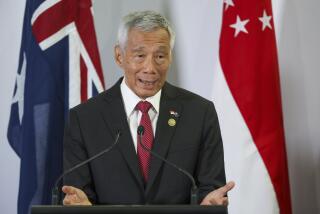TV Copter Finds Another Mine South of Strait
- Share via
DUBAI, United Arab Emirates — Another mine was found in coastal waters off the port of Fujaira on Wednesday, raising fears that the busy gateway to the Persian Gulf may now be heavily seeded with explosive charges.
The underwater mine, first sighted by an ABC television crew flying over the area in a helicopter, was spotted about five miles offshore in the northern part of the Fujaira anchorage, close to the spot where two mines were found Tuesday.
Over the past three days, six mines believed to have been laid by Iran have been found in the busy coastal waters south of the Strait of Hormuz, gateway to the Persian Gulf.
On Monday, the U.S.-owned supertanker Texaco Caribbean struck one of the mines about eight miles northeast of Fujaira in the Gulf of Oman. The blast tore a 12-foot hole in the side of the Panamanian-registered tanker, which spilled about 8,000 barrels of oil.
Two more mines were found by U.S. and Omani naval forces in the same area the following day, while the other three, including the one spotted Wednesday, were planted inside the crowded Fujaira anchorage itself.
Their discovery has shocked the gulf shipping community because it is the first time that mines have been laid outside the gulf, in an area that until now was considered the last safe assembly point for ships bound on the perilous journey through the Persian Gulf.
“It marks a major expansion of the area of conflict in the gulf war and is extremely worrisome to the (United Arab) Emirates, which derives a major part of its income from the port of Fujaira,” a shipping source said.
Five Feet Below Surface
However, the discovery of the latest mine carried even more disquieting implications because it was found about five feet below the surface, shipping sources said.
One maritime expert who inspected the area after the latest discovery said he believes that many more mines still lie undetected beneath the surface.
This and several other shipping sources, speaking only on the condition of anonymity because of the Emirates’ extreme sensitivity over the subject, said they believe that the Iranians meant544501536surface as traps for tankers.
“My guess is that the ones found on the surface were the goofs and that, while no one can be certain, it’s very likely that there are 15 or 20 more still out there, waiting to be hit,” one shipping source said.
Maritime sources in Fujaira said more than 20 tankers were anchored off the port, waiting for instructions. They added that most of the ships had moved into the southern part of the anchorage after port officials declared the northern end unsafe.
Several Emirates patrol boats and helicopters scoured the area for more mines but did not attempt to detonate the ones already discovered, the sources said.
“The Emirates armed forces don’t have much of a minesweeping capability, and they will probably have to wait for help,” one shipping source said.
Britain and France, reversing earlier decisions, both announced Tuesday that they will dispatch minesweepers to the gulf to help deal with this latest threat to the free flow of oil to the West.
Two French minesweepers and a support vessel are expected to join up in about two weeks with a French aircraft carrier task force now steaming through the Indian Ocean en route to the gulf, according to reports from Paris.
Four British minesweepers are expected to follow suit, arriving in the gulf in about five weeks.
The U.S. helicopter carrier Guadalcanal, with eight minesweeping copters aboard, is also in the Indian Ocean en route to the gulf.
Iran, in what shipping sources here dismissed as a propaganda maneuver, also offered Wednesday to help clear the waters outside the gulf of mines, claiming that they were in fact laid by U.S. forces.
Tehran radio said the Iranian Foreign Ministry has asked Emirates authorities for permission to send Iranian boats and minesweeping helicopters into the waters off Fujaira to “clear the area of mines planted by the United States, either directly or through its agents.”
Emirates officials, who have imposed a news blackout on the discovery of the mines, had no immediate comment.
However, shipping sources said they believe that Iran may have planted the mines both as a warning to the Emirates not to cooperate with the U.S. Navy’s escort of reflagged Kuwaiti tankers and as an attempt to give the U.S. forces in the gulf less room to maneuver.
The U.S. Navy has used the Fujaira anchorage to assemble the two convoys of reflagged Kuwaiti ships it has escorted through the gulf so far.
“It may be an attempt to warn the Emirates by showing that Iran can frighten off commercial shipping, and it could also be an attempt to keep the Guadalcanal from entering the gulf when it arrives,” one shipping source said.
While patrol boats from the Emirates and neighboring Oman combed the coast around Fujaira for more mines, at the other end of the gulf three U.S.-flagged Kuwaiti tankers began loading oil and gas for the retun leg of a U.S.-escorted convoy through the dangerous 550-mile-long waterway.
Shipping sources in Kuwait said they expect the convoy to sail for Fujaira, where they will transfer their oil to other ships, on Sunday.
The sources said the U.S. Navy, whose ships ironically are more vulnerable to mines than the large, thicker-hulled tankers, hired a civilian offshore supply vessel and, packing it with sonar equipment, used it as a makeshift mine detector to lead the convoy safely through the last and most perilous leg of the journey back to Kuwait.
More to Read
Sign up for Essential California
The most important California stories and recommendations in your inbox every morning.
You may occasionally receive promotional content from the Los Angeles Times.










